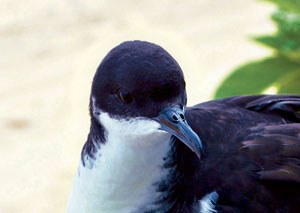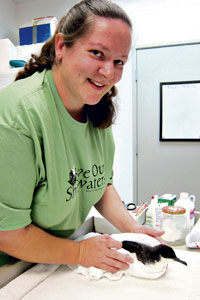Lending A Hand To ‘Kaua‘i’s Bird’
This is the season when Newell’s Shearwater fledglings begin making their way to the sea, and Garden Islanders can help when they fall
The light of the moon and the stars naturally guide Newell’s Shearwater fledglings from the mountains to the sea every year, from mid-September to mid-December.
However, when the moon is new or the sky is filled with clouds, these endangered native seabird babies become disoriented by artificial lights. In an attempt to reach the sea for the first time in their lives from steep cliffs and deep foliage in the central part of the island, they become distracted, circling the lights until they fall to the ground in exhaustion. Without the proper wind and conditions to take off again, they become vulnerable to dangers such as vehicles and predators.
The state recognized the issue some 30 years ago and established the Save Our Shearwaters program in an effort to help. The program encourages people to pick up any downed fledglings they may come across and bring them to aid stations located around the island, where people such as Tracy Anderson come to their rescue.
Anderson, Save Our Shearwaters program coordinator, and her small team either release the birds right away or nurse them back to health at their rehabilitation center at Kaua‘i Humane Society in Puhi.
When the birds enter the rehabilitation program, which can last from a few days to a few weeks, they are treated for ailments including dehydration, malnourishment, head injuries and broken bones.
Making sure the Newell’s Shearwaters’ feathers are waterproof also is of utmost importance, since their feathers are their only protection from the cold ocean water, and their down insulates them and provides warmth.
“Somebody needs to do it, and the need is there to do it,” says Anderson.
“They’re really cool little birds and worth saving.”
Approximately 90 percent of the endemic species’ entire population now exists only on Kaua‘i, a place they have called home for thousands of years. Prior to human arrival, the islands were covered with seabirds. In fact, the birds helped make the islands as lush as they are by digging out their burrows through lava rock, turning and fertilizing the soil.
“They helped to make these islands as beautiful and green and as fertile as they are,” Anderson says.
They also were helpful to Polynesians when they arrived in the Islands, as the birds helped direct them to fish.
“If we let them go to extinction, our biodiversity is lost,” says Anderson. “They’re special — they’re Kaua‘i’s bird.”
One of the qualities that make the Newell’s Shearwater, which is thought to have a life span of about 30 years, so special is its ability to live mostly at sea, returning to land only to nest. They also spend four or more years in the open ocean after fledging.
These seabirds have the ability to survive without fresh water, as they are part of the tube-nose family, meaning they not only have a developed sense of smell that most birds do not, they also have specialized salt glands in their heads which filter their blood and excrete a saline solution that drips from their tubes.
In addition, the Newell’s Shearwater (called ‘a‘o in Hawaiian) can dive some 30 to 42 feet for fish, with the deepest recorded dive being more than 150 feet underwater.
“That’s a long way for a small bird to go,” says Anderson, who has been a wildlife rehabilitator for 17 years and has worked with other birds such as eagles and trumpeter swans.
Sadly, a serious toll has been taken on these fascinating birds. Their numbers have declined dramatically in recent decades, and because they only lay one egg each year, which both parents incubate and raise, they have not been able to recover fast enough.
Their population also is likely on the decline because of the increase of introduced predators such as dogs and cats, as well as overfishing.
“But the lights are something we can control, so we can help these guys get back out to sea where they belong,” says Anderson, who urges people to make compassionate changes, including not keeping outside lights on unnecessarily and drawing curtains and blinds at night to shield indoor lighting.
Nonetheless, because of the Save Our Shearwaters program, it has been estimated that more than 30,000 birds have been collected since its inception, of which more than 90 percent have been released.
If a downed bird is found, it can be wrapped in a clean towel or picked up with clean hands — without lotion, insect repellent or sunscreen — and taken to the nearest aid station, and with information on the time and place the bird was discovered.
“At this time of year, if you live here, it’s a good idea to keep a clean box and clean towel in your car,” says Anderson.
The birds are picked up at the aid stations every day, and if it so happens that a bird is placed in one after the regular pickup time (noted at the station), Anderson asks that people contact the program so that the birds do not have to spend another 24 hours at the station.
“I enjoy releasing a bird that I know has a good chance of surviving in the wild and coming back to breed,” says Anderson.
Visit https://kauaihumane.org/services/saveourshearwaters for more information.
DOWNED BIRD DROP OFFS
Downed birds can be dropped off at these locations around Kaua‘i:
North Shore
Kilauea Medical Group
Princeville Fire Station
Hanalei Liquor Store
Eastside
Lihu‘e Fire Station
Kapa‘a Fire Station
Kaiakea Fire Station
Kaua‘i Humane Society
Westside
Waimea Fire Station
Hanapepe Fire Station
Kalaheo Fire Station
South Shore
Koloa Fire Station





